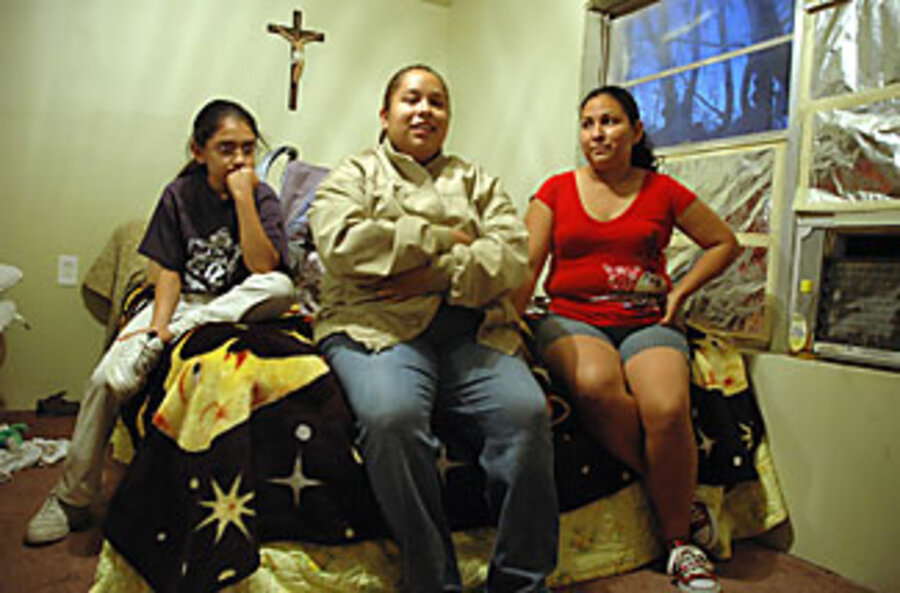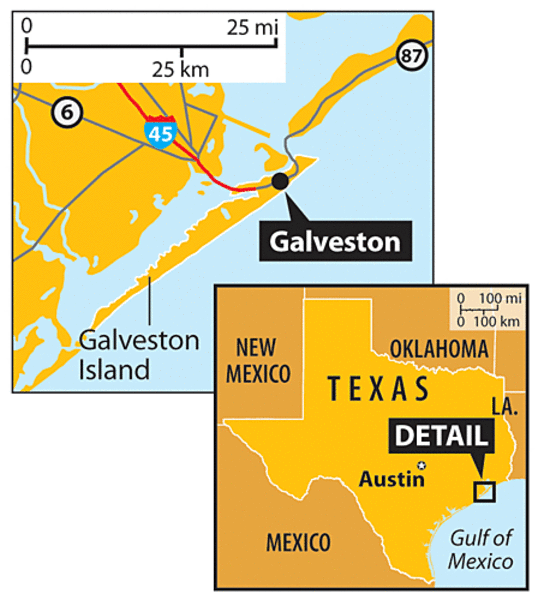Hit by hurricane Ike and unexpected layoffs, Galveston ponders its recovery
Loading...
| Galveston, Texas
This island city has a long history of rebounding from nature's most devastating blows. It withstood the hurricane of 1900, the country's deadliest ever, and is in the midst of picking up the pieces after hurricane Ike's furious assault in September.
But Galvestonians didn't expect the next storm. Last month the city's largest employer, the University of Texas Medical Branch (UTMB), announced it was laying off 3,800 people and would downsize the teaching hospital that is a central part of Galveston's economy.
"We can get back from Ike because there's a will to do it. It's what I call the Galveston spirit," says the city's mayor, Lyda Ann Thomas. "But UTMB was like dropping a bomb on the community."
The convergence of natural and economic disasters is forcing the city to search for new answers, especially in the midst of a national recession. It will take a reinvention, say many in this city known for its pluck.
"We anticipate a year or two of struggles from Ike, but you lay on top of that the recession and the outlook looks bleak," says Galveston City Manager Steve LeBlanc. "Galveston will come back in a different form."
Exactly what form it takes is the big question reverberating all over town.
Ike hit the city's tourism industry, its active port, and the UTMB medical facility hard. The Strand historic district, a major attraction, remains in tatters and few businesses have reopened. The port needs millions of dollars to recover and the hospital's island campus was besieged with floodwaters, adding up to $710 million in damages.
University officials say the layoffs are necessary to save the medical campus, which has the state's largest indigent care facility.
Mr. LeBlanc says the storm losses have the city looking for other alternatives – such as casino gambling. It's a moneymaker that has helped other coastal communities, such as Biloxi, Miss., cope with chronic hurricane problems. But just the thought of it has caused a tsunami of criticism here.
"Once again, the quick-fix boys are trying to promote casino gambling as an answer to Galveston's economic problems," wrote Galveston businessman Harris "Shrub" Kempner Jr. in Sunday's Galveston County Daily News. "The promoters typically wait for a period when Galveston has economic difficulties and then attempt to promote gambling as a cure for all our ills."
It's been two months since the 425-mile-wide storm crossed over Galveston in the early morning hours of Sept. 13. The storm killed at least 37 people in Texas and caused an estimated $8.1 billion in insurance losses. In Galveston alone, about 75 percent of the housing stock was damaged.
The city is still spotted with piles of debris from one end to the other. About 60 percent of the island's 57,000 residents have returned, according to city officials. Many are now struggling with their own questions about whether to restore homes, tear them down and start from scratch, or leave the island altogether.
Cristina Garcia's small ranch-style home sits in a low-lying section of the city that was flooded with six to eight feet of water during the storm. Many of the houses in her working-class section remain abandoned and boarded up. Some are for sale.
Like others who have returned to Galveston, Ms. Garcia can't actually live in her house. It has been gutted and is awaiting either extensive repairs and renovations or the wrecking ball. So the eight-member Garcia family – four children and four adults – live in their small backyard garage that has been fixed up with drywall and tin foil over the windows and outfitted with a large-screen TV and enough mattresses tucked away for sleeping.
"For me, it's OK," says Garcia, sitting with her daughter-in-law, Jurico, and daughter, Christina, in the garage decorated with religious icons, like the crucifix hanging on the wall above their bed. In Mexico her house was about the same size, but with dirt floors instead of carpeting. Even though she and her husband can make do, the garage isn't OK for her children, she says.
The Garcias asked the Federal Emergency Management Agency (FEMA) to place a trailer in front of their flood-ravaged house. But Garcia says the federal agency denied their request for a mobile home because placing one in her yard would violate city setback codes. But according to the city officials, those requirements, which dictate the distance a trailer can be placed from an excising house, were waved in Ike's aftermath.
"The city gave us permission to put a trailer here," says Jurico Garcia, translating for her mother-in-law, who speaks only limited English. "FEMA doesn't want to help us out with that. She fights with FEMA and she fights with the insurance company and it makes her head hurt."
It's unclear why the Garcias weren't given a trailer. FEMA has placed hundreds of them across Ike-ravaged Texas and promises thousands more to come. It could be because of a bureaucratic blunder – of the sort local officials charge have been plentiful at FEMA – or a misunderstanding on the part of the family, which is forcing it to stay snug inside its garage for months to come.
It's in these working-class neighborhoods of Galveston, a world away from the city's million-dollar waterfront villas, many also destroyed in the storm, where Chula Ross Sanchez hopes to see the most change in her city.
"This is an opportunity to build smart and plan smart," says Ms. Sanchez, a local design professional and member of the Galveston Planning Commission.
She'd like to see houses like the Garcias' rebuilt according to new codes, possibly elevated to help avoid future flooding, or even completely razed and replaced with sustainable and green housing.
Sanchez and a group of Houston architects are going to be sitting down with the Garcias to weigh the family's options for moving forward. They hope to do this with many more homeowners, many who may not think they have alternatives to simply renovating their existing homes. She says they'll help them navigate the entire process if they decide to work with the architects – from dealing with insurance agencies to finding grants that could be available to assist with the cost of rebuilding.
"If I can help one person, and maybe the neighbor around the corner, that's a good place to start – and the hope is that it blossoms to the whole neighborhood and another neighborhood," she says.
The idea is to start a new design paradigm across Galveston and establish a model for rebuilding in the city's most vulnerable neighborhoods, much the way Brad Pitt is doing in post-Katrina New Orleans with his Make It Right project. Galveston needs the sort of initiative like the one championed by Mr. Pitt, says Sanchez. It's a city awaiting a vision.
"We can coexist [with nature] on this island knowing what the consequences are," she says. "We can live with Mother Nature and still survive."
Other residents want to reinvent the city by returning it to its roots.
The Port of Galveston was a major American shipping route before the hurricane of 1900 but never fully rebounded from that storm and has been surpassed by the far busier port in nearby Houston.
"The port is really the major capital intensive industry here," says David Stanowski, a city resident and financial analyst. "We were the No. 1 port west of New Orleans; then the 1900 storm came."
In recent years, he says, there hasn't been enough capital investment in the port to keep it competitive. Now, he says, is the time to begin investing.
Still others want to take advantage of another Galveston resource – plentiful sand.
"One of the things our city is going to have to do is realize is that tourism is the only viable part of the economy that we have right now," says Gregory Roof, a Galveston resident and professor of economics at Alvin Community College in nearby Alvin.
"If people are hoping that UTMB is going to be our savior, or the port is going to be our savior, I don't think that's going to happen," he adds. "The savior for Galveston is going to be the beach."








